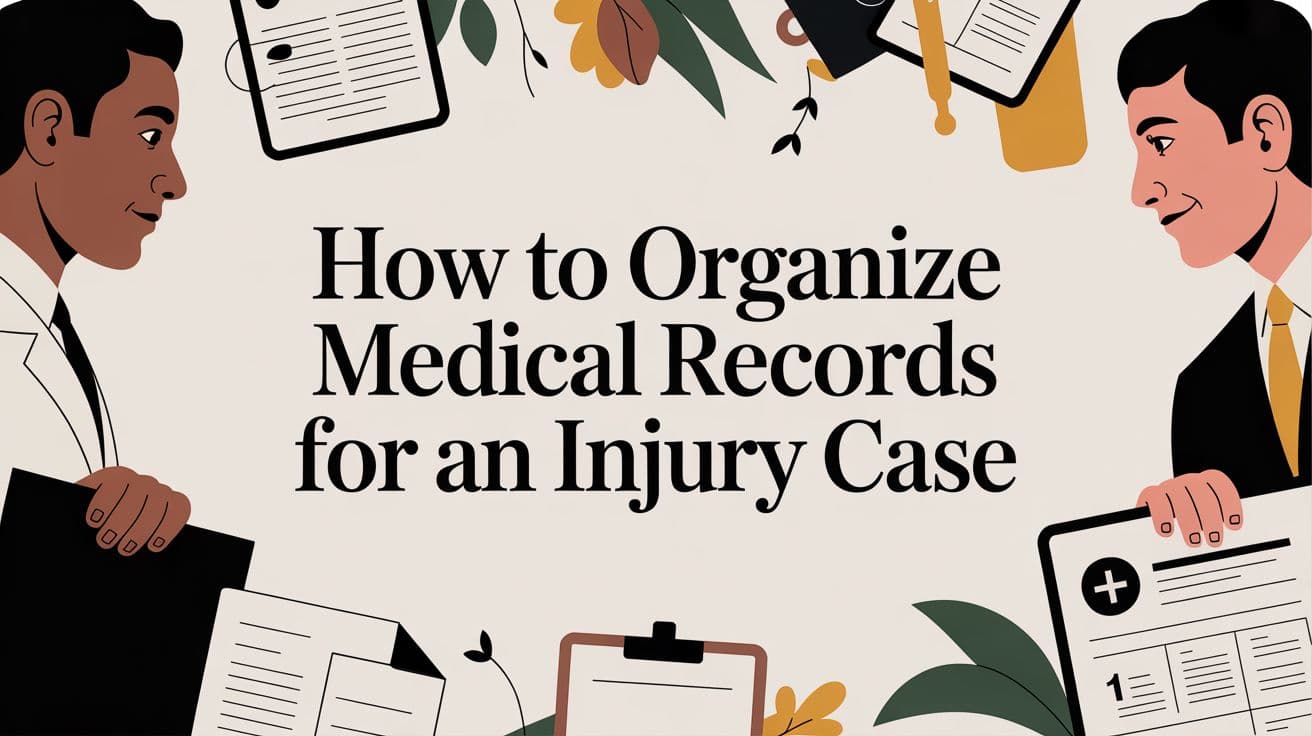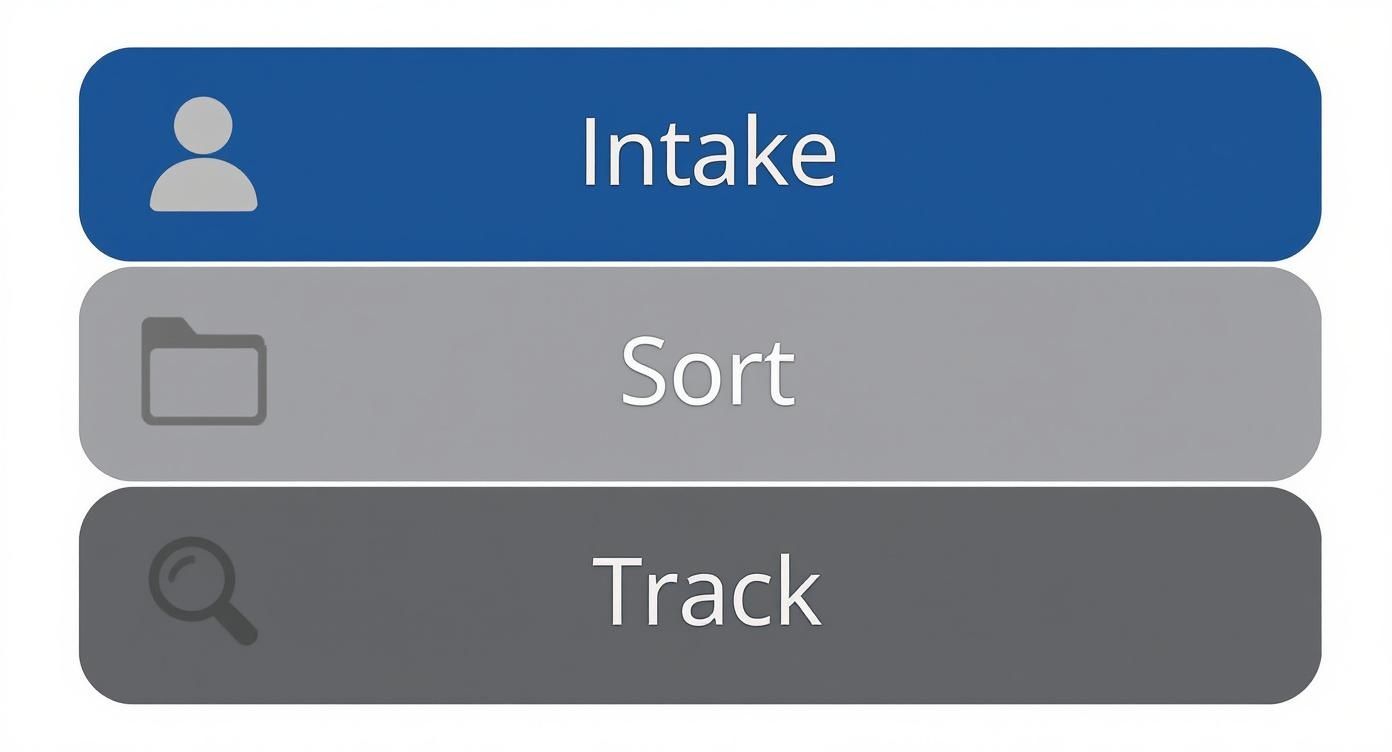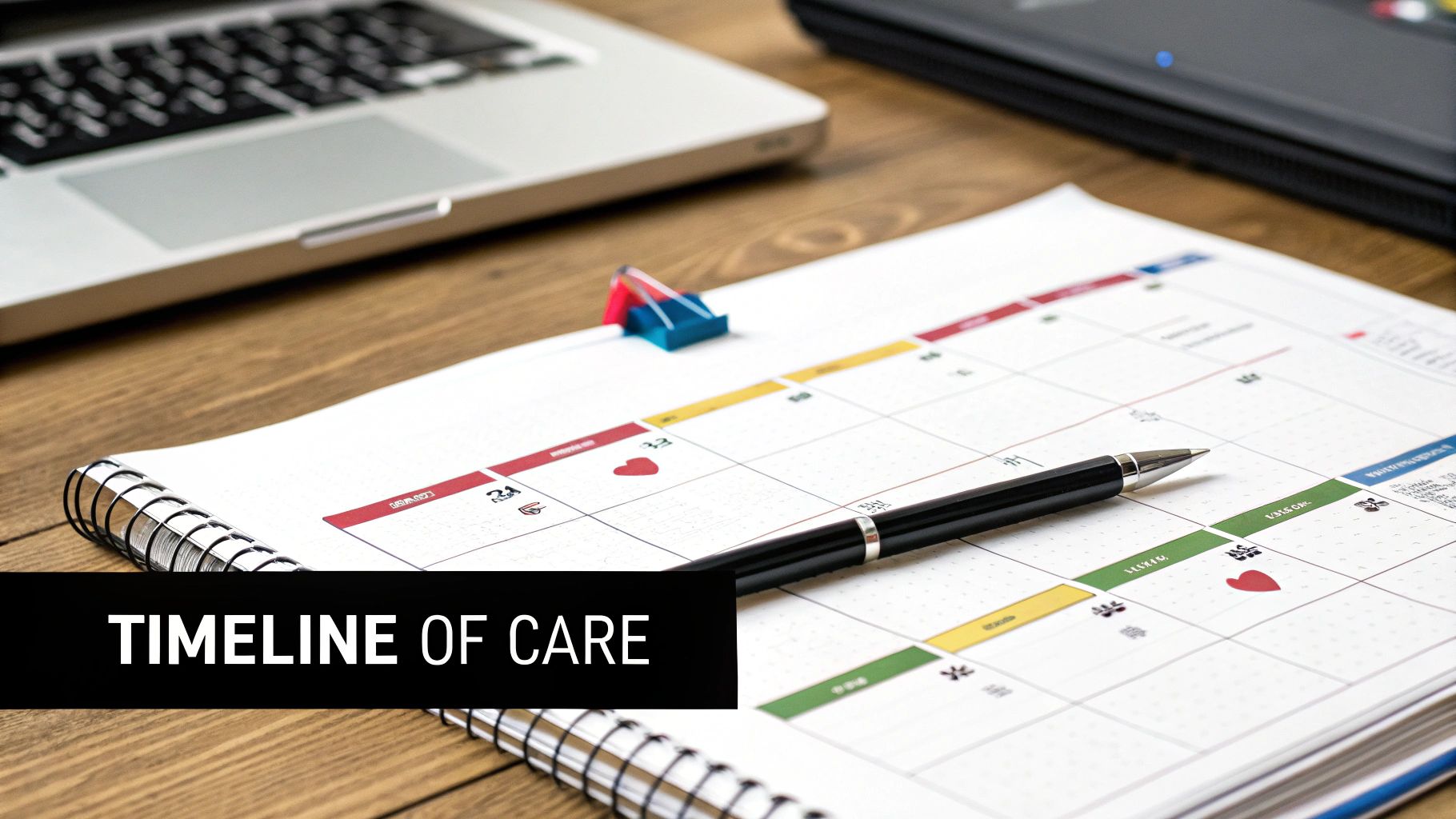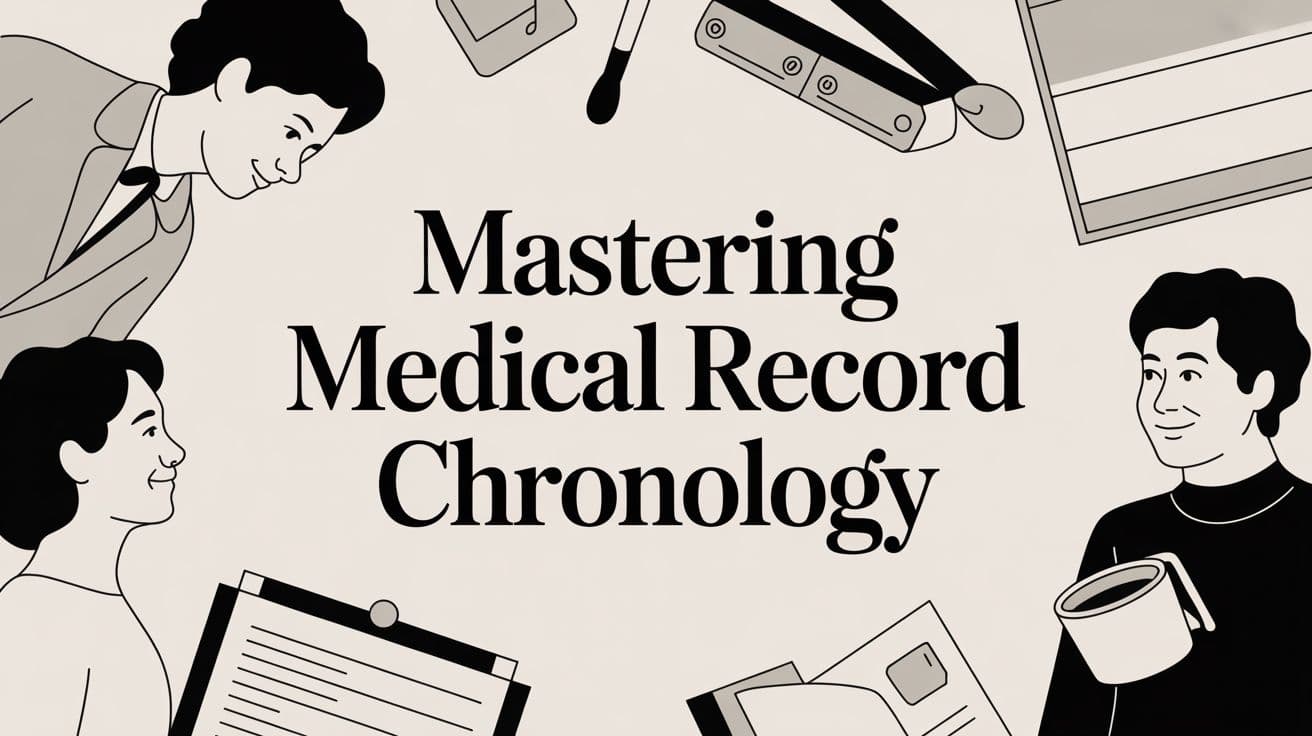How to Organize Medical Records for an Injury Case

Organizing the medical records in a personal injury claim is all about building a coherent, chronological story of your client's journey back to health. It's a meticulous process: you need to gather every single record, set up a bulletproof digital filing system, and then construct a detailed timeline that ties every injury, treatment, and cost directly back to the incident. Getting this right is absolutely fundamental to proving damages and building a case that can win.
Why Meticulously Organized Medical Records Are a Game-Changer

In a personal injury case, medical records are the bedrock of your argument, not just administrative clutter. A file stuffed with random PDFs and duplicate pages tells a muddled, unconvincing story. But a well-organized file? That presents a clear, powerful narrative that proves causation and quantifies damages, leaving very little room for a defense attorney to poke holes in your client's claim.
This isn't just about looking neat. It's a core legal strategy that directly influences settlement values and trial outcomes.
The Strategic Power of a Clear Narrative
When you can lay out a clean, chronological timeline of events, you seize control of the narrative. This methodical approach means you can instantly pull up the exact piece of information you need to substantiate the claim.
Connecting Injury to Incident: A clear timeline draws an undeniable line from the accident to the medical care that followed. This makes it incredibly difficult for the defense to claim the injuries were pre-existing or unrelated.
Substantiating Every Dollar: Organized billing records, physician's notes, and physical therapy logs provide concrete proof of economic damages. They become the unshakable foundation of your demand letter.
Spotting Weaknesses Early: A structured review process quickly flags any missing records or gaps in treatment. This gives you a crucial head start to address these potential vulnerabilities before the opposition can exploit them.
Think of it like this: a shoebox full of crumpled receipts is a weak way to prove business expenses. A meticulously organized spreadsheet, on the other hand, is hard to argue with. Your client’s medical file works on the same principle. The entire goal is to transform a chaotic pile of documents into a persuasive storytelling tool.
The High Cost of a Disorganized File
On the flip side, failing to properly organize medical records introduces serious risks that can weaken, or even completely derail, a case. Disorganization is a recipe for overlooked details, missed deadlines, and a compromised negotiating position. When a claims adjuster or defense attorney receives a messy, incomplete file, they immediately see an opening to undervalue the claim.
A disorganized medical record file is a wide-open invitation for the defense to challenge every part of your client's claim. It signals a lack of preparation and often leads to lower settlement offers because the full, compelling story of the injury is never clearly told.
The legal industry's move to digital records has only raised the stakes. The medical records retrieval market is projected to hit USD 2.8 billion by 2034, a surge driven by the adoption of AI and electronic health records (EHRs). This explosive growth highlights a critical reality for modern law firms: mastering digital record organization is no longer a "nice-to-have"—it's a necessity.
Ultimately, knowing how to organize medical records is about building a foundation of credibility. It demonstrates that you have an ironclad command of the facts and are ready to prove every single element of your client's damages. This foundational work is what turns a simple case file into your most persuasive asset. For more insights into boosting your firm's efficiency, check out our other posts on the Ares Legal blog.
Building Your Initial Record Triage System
The moment a client's medical records start flooding in, the clock is officially ticking. A disorganized pile of documents—whether it's a stack of paper on your desk or a folder of jumbled PDFs—is a major liability. That's why building a repeatable, front-end triage system isn't just a good idea; it's the most critical first step in turning chaos into a powerful case asset.
This isn't just about filing. It's about making smart, strategic decisions from the get-go.
Secure Authorizations and Map the Provider Universe
Your triage system should kick into gear the minute a client signs the retainer. The first order of business is getting the necessary medical authorizations signed and compiling an exhaustive list of every single provider they've seen. Honestly, this early diligence is what separates the pros from the amateurs. It's what prevents those frantic, last-minute scrambles for records that can stall a case for weeks, or even months.
Before you can even think about organizing records, you have to get them. This process starts with a really thorough client intake interview that zeroes in on their medical history. Your goal here is to create a master provider list that captures every single touchpoint in their journey to recovery.
Think comprehensively. This list must include:
All treating physicians and specialists (orthopedists, neurologists, pain management, etc.).
Hospitals and emergency rooms they visited right after the incident.
Urgent care clinics and any primary care follow-ups.
Physical therapy centers and other rehabilitation facilities.
Diagnostic imaging centers where they had MRIs, X-rays, or CT scans.
Pharmacies that filled prescriptions related to the injury.
For every single provider, make sure you have their full name, address, and phone number. This master list becomes your mission control, the central document you'll use to track every retrieval request. It keeps the whole process systematic and everyone accountable.
The Art of the Initial Sort
Once the records start rolling in, the real triage begins. The objective is simple: quickly separate the high-value, story-telling documents from the routine administrative paperwork. Let's be real—not all records are created equal, and your initial sort needs to reflect that.
An operative report detailing a complex surgery, for instance, is infinitely more impactful than a generic patient intake form. Your team needs a clear, established protocol for identifying and prioritizing these cornerstone documents the moment they arrive.
The initial triage isn't about deep analysis. It's about rapid-fire categorization. By quickly identifying and flagging the big-ticket items—the ER report, operative notes, the initial specialist consult—you start to establish the core narrative of the injury right away.
This early sorting lays the groundwork for the entire case. The good news is that the rise of Electronic Health Records (EHRs) has made this job a lot more manageable. In the U.S., EHR adoption in hospitals shot up from just 12% in 2009 to over 96% by 2021. We've seen similar trends across the globe, with high adoption in the EU (86%), Australia (93%), and Canada (79%).
What does this mean for you? It means you're far more likely to receive searchable, well-organized digital files instead of the messy, often illegible paper records of the past. This shift can seriously speed up your triage process. You can learn more about the global trends in electronic medical records systems to understand the landscape better.
Medical Record Triage Priority Matrix
When records first arrive, it’s essential to quickly identify which documents will have the biggest impact on your case. Not every page carries the same weight. A detailed surgical report, for example, is far more critical in the early stages than a routine billing statement. This priority matrix is a practical guide to help your team triage incoming records effectively, ensuring you focus on the most influential documents first.
| Record Type | Priority Level | Key Information Provided | Common Use in Litigation |
|---|---|---|---|
| Operative Reports | Highest | Details of surgical procedures, findings, hardware used, surgeon's notes. | Proves the severity and necessity of invasive treatment; crucial for damages. |
| ER/Hospital Records | Highest | Initial diagnosis, trauma assessment, imaging results, admission/discharge summaries. | Establishes the immediate aftermath of the incident and initial medical response. |
| Specialist Consultations | High | Expert opinions (e.g., orthopedic, neurologic), causal connection, prognosis. | Forms the basis of expert testimony and future medical needs assessments. |
| Diagnostic Imaging Reports | High | Radiologist interpretations of MRIs, X-rays, CT scans showing objective injuries. | Provides objective, visual evidence of physical harm (e.g., herniations, fractures). |
| Physical Therapy Notes | Medium | Progress logs, pain levels, functional limitations, treatment consistency. | Demonstrates the client's effort to mitigate damages and ongoing functional deficits. |
| Prescription Histories | Medium | Medications prescribed for pain, inflammation, etc., and refill dates. | Corroborates pain and suffering claims; shows the timeline of treatment. |
| Billing Records/Ledgers | Low | Itemized costs of services, CPT codes, total medical expenses. | Used to calculate economic damages (medical specials) later in the case. |
| Administrative Forms | Lowest | Patient intake forms, HIPAA releases, insurance information. | Generally used for background information; rarely central to the legal arguments. |
By categorizing records this way, you ensure that the documents forming the core of your liability and damages arguments are reviewed and summarized first. This strategic approach streamlines case development and prepares you for critical deadlines far more effectively.
Track Meticulously and Flag the Gaps
A truly great triage system isn't just about what you have—it’s about what you don't have. As you process incoming documents, you need to be constantly cross-referencing them against your master provider list and the client’s known treatment timeline.
The key is a simple tracking system. This can be a dedicated spreadsheet or a built-in feature in your case management software. The tool doesn't matter as much as the discipline.
This rigorous tracking lets you spot a non-responsive provider early on. Instead of discovering a massive hole in the records weeks before a deposition or mediation, you can identify the problem and follow up proactively. This transforms the intake process from a passive collection phase into an active, strategic hunt for the evidence you need to build a winning case.
Building Your Digital Filing System
With the initial sorting done, it’s time to build the digital framework where every medical record will live. Let's be honest, a folder named "Smith-Medicals" on a shared drive just doesn't cut it. That approach leads to chaos. What you need is a logical, consistent system that anyone on your team can understand at a glance.
Think of this as creating the architectural blueprint for your case files. Get it right, and you eliminate guesswork, prevent lost documents, and establish a single source of truth for every single case.
A Folder Structure That Actually Works
Consistency is the name of the game here. The goal is to create a predictable folder hierarchy that you can replicate across every client file, every single time. It's just like setting up a physical filing cabinet—you want clearly labeled drawers and dividers so you’re not just rummaging through a mountain of paper.
I've found a top-down structure works best for most personal injury firms. It's intuitive and easy to navigate.
Here’s a practical example you can adopt today:
Client Last Name, First Name [Case Number]
Pleadings
Discovery
Correspondence
Medicals
General Hospital
ER Records
Billing
Radiology
Orthopedic Specialists
Consults
Operative Reports
Physical Therapy
This nested approach keeps related documents together. Anyone on your team can quickly drill down from the client level to a specific provider and find the exact record they need in seconds. No more frantic searching before a deadline.
The Secret Sauce: A Standardized Naming Convention
A smart folder structure is a great start, but it's only half the battle. If your folders are filled with files named "scan_doc_001.pdf" or "MedRecs_Page_4.jpg," you're still creating unnecessary work for yourself. A consistent file naming template is absolutely non-negotiable for an efficient practice.
The most effective convention I've seen leads with the date, which automatically sorts your files in perfect chronological order. Try this template:
YYYY-MM-DD_RecordType_ProviderName.pdf
For instance, a file would look like this: 2023-01-15_ER-Report_General-Hospital.pdf. Without even opening the file, you instantly know the date of service, what the document is, and where it’s from. This small discipline pays off in a huge way when it comes to team productivity.
A standardized naming convention does more than just keep you organized. It creates a universal language for your entire firm. It's the difference between a chaotic library with books scattered everywhere and a perfectly cataloged system where every volume has its place.
This structured approach is the foundation for the entire record management workflow, from intake to ongoing case analysis, as this infographic shows.

As you can see, sorting and organizing isn't just a preliminary step; it’s the central pillar that supports everything that follows.
Unlock the Power of Your Documents with OCR
There’s one final step that can turn your digital archive from a simple storage system into a powerful analytical tool: making every single document text-searchable.
Most records arrive as "flat" PDFs or image files. To your computer, these are just pictures of text, not actual text it can read. This is where Optical Character Recognition (OCR) software comes in. This technology scans the document image and converts it into a machine-readable, fully searchable PDF.
Suddenly, you can hit Ctrl+F (or Cmd+F on a Mac) and instantly find every mention of a specific injury, doctor, or treatment across hundreds of pages. It’s a complete game-changer. This simple step saves countless hours.
More importantly, making your documents text-searchable is the key to unlocking modern AI platforms like Ares Legal. These tools need readable text to work their magic—automatically building chronologies, extracting key data, and flagging critical details you might have missed. Of course, protecting this data is paramount. You can learn more about the enterprise-grade security measures needed for HIPAA-compliant storage and how we keep sensitive client information safe.
Crafting a Compelling Medical Chronology

Once you’ve got your digital filing system humming, the real work begins. Organizing the files is the setup; building the medical chronology is the payoff. This is where you transform hundreds—sometimes thousands—of pages of dense clinical notes into a clear, persuasive story of your client's injury and recovery.
A powerful chronology is so much more than a list of dates. It’s a strategic tool. It connects the dots for claims adjusters, opposing counsel, and mediators, making the client's journey through injury, treatment, and mounting damages impossible to ignore. It is, without a doubt, the narrative backbone of any strong personal injury claim.
From Data Points to a Powerful Story
The first pass involves a systematic review of every single document. Your mission is to pull out the legally significant data points from each record. This takes a sharp eye—you have to learn to sift through the clinical jargon and zero in on the details that actually build your case.
As you review, you should be meticulously logging key information for every single entry. This consistent extraction process is what turns a pile of disparate records into a unified, coherent timeline.
Here’s what I always look for:
Date of Service: The exact date of the appointment, procedure, or test.
Provider and Facility: The doctor’s name and the clinic or hospital.
Diagnoses and Complaints: What the patient said was wrong and what the doctor officially diagnosed (including ICD codes if you can get them).
Treatments and Procedures: Details on surgeries, physical therapy, prescriptions—any intervention.
Medical Costs: The billed charges for that specific service.
This methodical work is the foundation. It creates a structured database of events that you can then weave into the compelling narrative for your demand letter.
The Art of the Summary
Extracting data is one part of the job; summarizing it effectively is the other. A rookie mistake is to just copy and paste huge blocks of text from the medical records. All that does is create a chronology that’s just as dense and unreadable as the original source files.
Your real goal is to distill each entry into a concise, legally impactful summary.
Let's look at a real-world example. Instead of pasting a long, technical paragraph from an ER report, a strong summary looks like this:
Original Entry: "Patient presents to the ED via ambulance s/p MVC. C/o severe L shoulder pain and inability to abduct arm. X-ray of L shoulder reveals an acute comminuted fracture of the proximal humerus. Placed in sling, given Toradol for pain. Ortho consult advised. Discharged with instructions for outpatient ortho f/u within 2-3 days."
Chronology Summary: "ER visit at General Hospital post-accident. Diagnosed with a severe left shoulder fracture (comminuted proximal humerus fracture). Patient was immobilized, given pain medication, and referred for an urgent orthopedic follow-up."
See the difference? The summarized version is clear, direct, and immediately understandable to anyone reviewing the case, regardless of their medical background. It captures the essential facts without the clinical noise.
The widespread adoption of Electronic Health Records (EHRs) has certainly helped organize this data on the provider side. The EHR market was valued at an estimated USD 33.43 billion in 2024, and it dictates how most medical data is structured today. While this digital format can make it easier to find key information, the critical thinking needed to summarize it for a legal context remains a vital human skill. You can learn more about the dynamics of the EHR market to see how these systems are evolving.
Identifying Gaps and Building Your Case Strategy
A well-built chronology does more than just tell a story—it also shows you what's missing. As you lay out the timeline, treatment gaps or missing records become glaringly obvious.
Did the client wait six weeks before seeing a specialist? Is there a two-month period with no physical therapy notes? Spotting these issues early is a massive strategic advantage. It gives you a chance to get ahead of the problem, discuss it with your client, and formulate a response before the defense attorney uses it to argue that the injuries weren't serious.
This makes the chronology an invaluable tool for case strategy. It highlights both the strengths and the potential weaknesses of your claim long before you ever get to the negotiating table. It's the single most effective way to gain a deep, comprehensive understanding of your client’s medical journey and the roadmap you'll use to win the case.
Manual vs. AI-Powered Chronology Creation
Building a chronology has traditionally been a time-intensive, manual process. But now, AI-powered platforms like Ares Legal are changing the game by automating much of the heavy lifting. This shift allows legal teams to focus more on strategy and less on tedious data entry.
The table below breaks down the key differences between the old way and the new way.
| Process Step | Manual Approach (Time & Effort) | Ares Legal AI Approach (Time & Effort) | Key Benefit of AI |
|---|---|---|---|
| Initial Data Extraction | 8-10+ hours. A paralegal manually reads every page to find and log key data points. | Minutes. AI scans all documents, extracts dates, providers, diagnoses, and treatments automatically. | 95%+ time savings on initial data entry and drastically reduced human error. |
| Drafting Summaries | 4-6 hours. Involves manually re-reading notes and writing concise, legally relevant summaries for each entry. | Seconds. AI generates draft summaries for each entry, ready for human review and refinement. | Frees up paralegal time for higher-value strategic tasks and ensures consistency. |
| Identifying Gaps | Incidental. Gaps are often found by chance during the review process, requiring a keen eye. | Automated. The system flags chronological gaps in treatment automatically for immediate review. | Proactive issue spotting; nothing falls through the cracks. |
| Linking Records to Bills | 3-5 hours. A tedious, manual process of matching every CPT code on a bill to a specific date of service. | Automated. AI cross-references medical bills with service dates, linking them automatically. | Eliminates a major source of administrative burden and potential errors. |
Ultimately, integrating AI doesn't replace legal professionals; it empowers them. By handling the most repetitive and time-consuming aspects of chronology creation, tools like Ares Legal let your team focus on what they do best: building a winning case strategy.
Using AI to Radically Speed Up Record Review
Once you have a solid digital filing system in place, you start to see just how much manual work goes into crafting a medical chronology. It’s a grind. But the painstaking, hours-long process of sifting through records is no longer the only way.
Modern AI platforms are built specifically to handle the heavy lifting of medical record organization, turning what was once a multi-day task into something that takes just a few minutes.
This isn't just about doing the same old work faster. It’s about completely changing how your team approaches a new case. By automating the grunt work, you free up your best people to focus on high-level legal strategy, building a stronger case from day one. An AI-powered tool like Ares Legal handles the most time-consuming steps for you.
Putting the Core Organizational Workflow on Autopilot
Picture this: you upload a single folder stuffed with hundreds of disorganized medical records. Within minutes, you get back a perfectly sorted, named, and organized file. That’s what AI brings to the table.
Instead of a paralegal manually opening every single file, trying to figure out what it is, renaming it according to your firm’s convention, and dragging it to the right folder, the AI does it all instantly.
This automated process also enforces total consistency. Every file gets named the same way, every time. Every record is placed in its proper chronological and provider-specific folder without fail. It completely eliminates the human errors—typos, misfiled documents—that can cause massive headaches later on.
Essentially, the platform performs the entire triage, sorting, and filing process you worked so hard to establish, but with the speed and precision only a machine can offer.
Generating an Instant Chronology
The biggest game-changer is the AI's ability to generate a comprehensive medical chronology almost on the spot. After you upload your documents, the system scans every text-searchable page, using natural language processing to pinpoint and pull out the most critical data.
It automatically extracts:
Dates of Service to build out the complete timeline.
Provider Names and Facilities to see who did what, and where.
Diagnoses and Patient Complaints to understand the client’s injuries.
Treatments and Prescriptions to detail the entire medical response.
What you get is a structured, interactive timeline of the client's entire medical journey. This isn’t just some static list; it’s a dynamic tool. You can filter the entire history by a specific provider, search for keywords like "herniated disc," and click on any entry to jump straight to the source document it came from.
A task that once took a skilled paralegal a full day (or more) is now a foundational asset you have at the very beginning of the case.
The screenshot below gives you a sense of the intuitive dashboard in the Ares Legal platform, which is designed to make complex information clean and accessible.
This view provides an immediate, high-level overview, letting you grasp the key facts and narrative of the case in seconds.
Keeping It Accurate with Smart QC Tools
A common worry with automation is whether you sacrifice accuracy for speed. The best AI platforms are built with this in mind, integrating quality control (QC) and verification features right into the workflow.
The system isn't meant to replace a human expert—it's meant to make them more powerful. For instance, the AI can automatically flag potential discrepancies, like a billing record that doesn't match a known date of service or a treatment note that seems out of chronological order.
By automatically highlighting potential gaps or inconsistencies in the records, the AI essentially acts as a second set of eyes for your team. This shifts your paralegals from tedious data hunting to strategic verification, letting them focus their expertise where it truly matters.
This turns what used to be a reactive search for errors into a proactive quality check. Your team can quickly investigate the flagged items, confirm the details, and make the case file even stronger. It’s a true partnership between human experience and machine efficiency.
Sharing and Collaborating Securely
Finally, what’s the point of organizing all these records if you can’t share them safely? Sending protected health information (PHI) through standard email is a huge security risk and a potential HIPAA nightmare. The penalties for non-compliance are no joke, reaching over $2 million per violation in some cases.
An AI platform like Ares Legal solves this by providing a secure, HIPAA-compliant environment for both storage and sharing. You can grant controlled access to specific documents or the entire chronology to your medical experts or co-counsel, all within an encrypted, professional portal.
This lets you collaborate effectively without ever compromising client confidentiality or risking a run-in with strict privacy regulations. It streamlines one of the most nerve-wracking parts of managing medical records, giving you and your firm much-needed peace of mind.
Common Questions About Medical Record Organization
Even with a rock-solid system, dealing with medical records will always throw you a few curveballs. Every case has its quirks, from providers who won't return your calls to confusing gaps in a client's treatment timeline. Let's tackle some of the most common questions that pop up.
These are the real-world headaches that can derail a case. Knowing how to handle them is what separates a good workflow from a great one.
What Should We Do About Missing Records Or Treatment Gaps?
Finding a missing record or a gap in treatment can feel like a punch to the gut, but it happens all the time. The trick is to get out in front of it and make it part of the case story, rather than a weakness the defense can exploit.
First, you need an undeniable paper trail. Log every single attempt to get those missing records—every call, email, and fax. If a provider is still stonewalling you, send a formal request via certified mail with a hard deadline. This diligence shows you've done your due diligence and then some.
If the issue is a gap in treatment, the first step is always a candid conversation with your client. There's almost always a good reason.
Did they not have a car to get to physical therapy appointments?
Was the co-pay just too high to manage every week?
Did they start feeling better and assume they didn't need to continue?
Getting this context down on paper is crucial. It lets you frame the gap honestly and proactively, cutting off the defense's argument that your client wasn't really hurt or failed to mitigate their damages.
What Is The Most Secure Way To Share Large Medical Files?
Tossing a huge file of medical records into an email attachment is a massive gamble. Standard email isn't HIPAA-compliant, and it puts your client's protected health information (PHI) at serious risk. One accidental "reply all" could spiral into a major data breach.
The gold standard is to use a secure, encrypted file-sharing portal. Many practice management platforms have this built-in, and so do specialized tools like Ares Legal. These systems give you a controlled, locked-down environment for sharing sensitive information.
Here’s a pro tip: When you're sharing files with an expert witness or co-counsel, always stick to the principle of "minimum necessary access." Only give them what they absolutely need. Your orthopedic expert doesn't need to see the psychiatric consult notes. This simple step drastically reduces data exposure and shows your commitment to protecting client privacy.
How Long Must We Retain Medical Records After A Case Closes?
Every firm needs a written, easy-to-understand file retention policy. Your state bar association sets the rules, but the timeline is usually somewhere between five and seven years after a case is officially closed.
To make this manageable, digitize everything. Paying for physical storage for that long is a money pit, not to mention the risk of fire, floods, or just plain losing things. A secure digital archive is infinitely easier to manage, search, and securely dispose of when the time comes.
As a final piece of housekeeping when you close a case, always offer your client a complete digital copy of their file. It’s a great final touch that ensures they have what they need and formally wraps up your responsibility for their documents.
Can AI Tools Really Replace A Paralegal For This Work?
This question comes up a lot, and the answer is a firm "no." AI tools are here to augment your paralegals, not replace them. Think of AI as a superpower for your most experienced team members.
AI is brilliant at the monotonous, soul-crushing tasks that bog your team down—like sorting thousands of pages, applying consistent file names, and creating a first-draft chronology. This kind of automation can easily wipe out 10+ hours of manual work on a single case.
That frees up your paralegals to do the high-value work that actually moves the needle. They can shift from data entry clerks to strategic analysts, digging for the case-winning details, flagging inconsistencies, and drafting sharp summaries for the attorneys. If you have more questions about how these tools fit into a real-world workflow, we're always happy to help you figure it out when you get in touch with our team.
Ready to eliminate the tedious hours spent on manual record review and build stronger cases faster? The Ares Legal AI platform automates the entire process—from sorting and organizing records to drafting a comprehensive medical chronology in minutes.
Discover how Ares Legal can transform your personal injury practice today.


